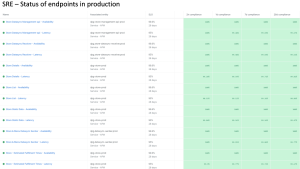Observability is critical for developers. It gives them the real-time visibility and insights they need to stay productive and avoid incidents. But observability isn’t just for engineering teams. For C-level executives, visibility into user experience and customer journeys is top of mind, New Relic is able to show these key performance indicators (KPIs) in easy to understand dashboards.
Here are five examples of the executive-level benefits of New Relic, as told by the customers themselves.
1. Quickly driving productivity and proving value
The New Relic free tier—which includes 100 GB of data ingest—has proven particularly popular among executives, it shows that New Relic delivers value quickly without having to allocate any budget at all.
“My goal was to use the free tier to demonstrate value to our company’s leadership and make the case for an expanded observability deployment,” said Hendrik Duerkop, director of infrastructure and technology at Statista. “The justification was easy to understand: our monthly bill with New Relic is equivalent to four developer hours while delivering massive savings in money and resources … The introduction of the New Relic free tier has been a pivotal moment for Statista, enabling us to identify and address some of our most persistent challenges.”
C-suite leaders themselves appreciate the immediate value delivered by New Relic. “In New Relic, everything is tracked automatically,” said Casey Li, CEO of customer software agency BiteSite. “Unlike other platforms, we don’t have to pick and choose what’s important from the outset. So when a customer has an issue, we know we’ll have the data we need. For example, when a customer says something is loading slowly, New Relic might show that the fetch to the database is taking up 20% of the response time, while the HTML render is only taking up 5%. This information is immediately actionable—we understand where the performance problem is and can work on reducing it. It’s not just that the information from New Relic is actionable, but the solution is usually very easy to implement.”
2. Breaking down silos to improve system resilience
Tech leaders use New Relic to achieve goals set by their executives, universally this means less silos and more reliable performance in order to improve the customer experience.
“M&S dramatically shifted our traditional retail approach for the omnichannel consumer in the drive to be digital-first in 2018,” said Steven Gonsalvez, principal engineer at M&S. “To keep up with this digital transformation, my engineering team had to introduce new tech. New Relic has helped M&S reduce MTTR by one-third, a massive win. This improvement demonstrates the real value of observability—minutes of downtime and poor customer experience all relate to revenue, but they also impact long-term customer retention and lifetime customer value.”
“The ability that New Relic provides to allow you to correlate specific requests or between services all the way from infrastructure through to the front end is really powerful and makes it a lot easier to diagnose issues … before they arise,” said Graham Little, director of engineering at 10x Banking. “That helps us build our culture as well. We’ve got engineers talking to each other across different teams, getting to know each other and breaking down some of those silos.”
“Having all our data available in one place allows me to make informed decisions,” said Joseph Wogan, principal platform engineer at 10x Banking. “It makes me feel empowered that I have the ability to deliver a great customer experience to our clients.”
3. Communicating what matters to the business
New Relic gives developers and engineering leaders the data to communicate more effectively with executives and business leaders.
“The technical metrics are not necessarily the ones that you care about,” said JD Weiner, director of DevOps at Forbes. “You don’t necessarily care about memory usage or five-minute load on the system. What you care about are the metrics that matter to the business. Those are things like customer satisfaction metrics, and that’s the direction we’re moving in at Forbes.”
“What I like about New Relic is having everything available to me in a single place,” said Patrick Hyland, senior engineering manager at Domino’s Pizza UK and Ireland. “I can have very predictable conversations with my SRE engineers. It results in a common language and the ability to talk in a clear and effective way about site reliability and engineering situations.”
4. Delivering proactive support for peak demand performance
For retailers and other customer-facing organizations, reliability is most important during moments of peak demand. New Relic ensures that a company will be able to keep pace during its busiest seasons—something executives keep a close eye on.
“To prepare our site for triple the traffic during the holiday season, we need team collaboration, and most importantly, the insight to adapt our infrastructure to add new services and capabilities,” said Manuel Garcia, senior principal engineer at farfetch.com. “We need to deliver business growth without compromising on user experience … New Relic is crucial to achieve this and ensure that we have a successful sales season.”
The pressure to perform is even stronger for the online gambling company William Hill, which sees regular peaks during major sports seasons.
“On a typical Saturday, over five million messages get processed through our system,” said Rashid Mattin, software engineering manager at William Hill. “We have a complex platform whereby we have over 400 microservices running, and trying to find where the error is within 400 apps can be quite challenging. So when we’ve got the right observability, and when we’ve got things like OpenTelemetry and we can trace, it helps reduce our MTTR.”
5. Simplifying security to reduce application risks
As companies face more stringent privacy regulations—and as executives steer their organizations away from security risks—New Relic simplifies the process of identifying and resolving vulnerabilities. These regulations are particularly important for companies dealing with health and financial data.
“When it came to security within William Hill and within trading, we used a number of tools such as container security scanning and container runtime scanning,” said Mattin. “We also had security scanning integrated into our pipelines. However, a lot of this information would be surfaced to the SRE team or to the InfoSec team. What New Relic and the Security RX tool enabled us to do was present and surface that data to the developers.”
“In anticipation of growth and the need to meet the rigors of healthcare security standards, we needed a tool to help diagnose and predict the performance and robustness of our technologies,” said Aretha Delight Davis, founder and CEO of ACP Decisions, a non-profit foundation helping people make more informed medical decisions. “New Relic is not only a telemetry platform but also services the triad of understanding the state of a system through its observability, monitoring and telemetry capabilities.”
The views expressed on this blog are those of the author and do not necessarily reflect the views of New Relic. Any solutions offered by the author are environment-specific and not part of the commercial solutions or support offered by New Relic. Please join us exclusively at the Explorers Hub (discuss.newrelic.com) for questions and support related to this blog post. This blog may contain links to content on third-party sites. By providing such links, New Relic does not adopt, guarantee, approve or endorse the information, views or products available on such sites.


